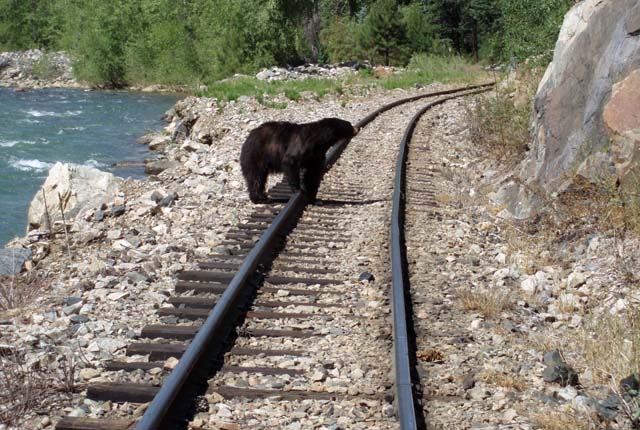
Bears to Rails
Banff Alberta - Conservationists fear it's just a matter of time before a grizzly bear is struck and killed on the train tracks in Banff National
Park after learning Canadian Pacific Railway (CP) has not had its vacuum truck out to clear spilled grain this spring.
Instead, the railway giant has been using a large train-mounted blower to remove grain from between the rails during the colder months when the vacuum truck is
less effective, but conservationists say the tracks have been clear of snow for quite some time now.
They say bear 122, a large dominant male grizzly bear known affectionately as The Boss, has regularly been seen wandering along the train tracks in Banff
National Park where there's spilled grain.
"This idea that you can remove grain from between the rails and simply blow it out into the park is absurd and it represents a step back to the CP dark
ages, which is really disappointing," said Jim Pissot, executive director of Wild Canada Alliance.
"The Boss is always the first one out and he's on the tracks. People are furious enough when cubs and other bears have been killed on the tracks, but if
this iconic bear was to lose his life to the railway, it would be totally unacceptable."
In a note sent to Pissot, Banff resource conservation manager Bill Hunt said Parks has clearly communicated with CP that they prefer spilled grain be collected
and removed with the vacuum truck as much as possible given the conditions, rather than blowing it off the rails.
"The latter solution does not remove the attractant, but simply moves it to a potentially safer location for wildlife," wrote Hunt in the note to
Pissot.
A total of 14 grizzlies have died on the railway tracks in Banff and Yoho since 2000.
Another 11 grizzly bears have been killed on highways in the national parks over the same time period.
Parks Canada and CP teamed up on a five-year joint action plan try to reduce the number of bear deaths on the railway line through Banff and Yoho national
parks.
The results are not expected to be made public until the fall.
As part of the action plan, CP contributed $1 million to support various research projects to improve understanding of the causes of bear-train collisions,
other than solely spilled grain.
The work has included studying the movements of grizzly bears through GPS collaring and considering the use of prescribed fire to create better habitat to draw
bears away from the tracks.
Among other things, researchers have also been looking at the potential of fencing select hot spot sections of the railway line, using a combination of
electrified mats to prevent animals from entering the fence opening with electric fences.
Pissot said CP has fixed the most serious leaking hopper cars and did commit to the five-year action plan, but he said evidence shows grain continues to be
spilled along the tracks in the parks.
"Spilled grain continues to be a problem," he said, noting it attracts wildlife such as bears, especially in spring when hungry bears just out of the
den are searching for any sign of food.
CP did not grant an interview or answer questions on when they expect to have the vacuum truck out in the parks, but instead sent an emailed
statement.
"CP is well positioned to manage and mitigate risk to local bear populations in coordination with Parks Canada," wrote spokeswoman Salem
Woodrow.
"CP's preferred approach is to use a vacuum truck when circumstances allow and will deploy it as required."
Parks Canada also provided a statement with little information, noting removal of the grain with a vacuum truck is the preferred method when conditions
permit.
"Parks Canada encourages any member of the public who notices grain spills to contact Banff Dispatch (403-760-1470) with the location so that we can work
to remedy the situation," said Parks Canada spokesperson Christina Tricomi in the statement.
Cathy Ellis.



